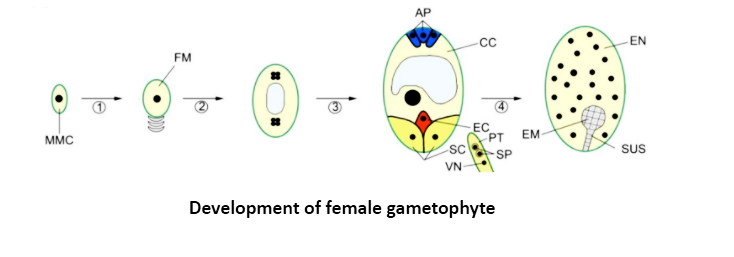
Explain the development of female gametophyte in angiosperms? Illustrate the answer with a suitable diagram?
Answer
492k+ views
Hint: The mature female gametophyte produces proteins to direct the pollen tube into the embryo sac, and contains protein complexes that prevent pre-fertilization seed growth.
Complete answer:

> A single cell from the internal tissue (called the nucellus) is known as a 'archesporal' cell in the developing ovule, which is expanded and transformed into the female meiocyte or megaspore mother cell (MMC). The MMC undergoes meiosis to generate four spores, three of which endure programmed cell death, retaining as functional megaspore only the proximal (chalazal) megaspore (FM stage or female gametophyte stage 1 or FG1 in each ovule).
> Then, the megaspore undergoes three sequential nuclear mitotic divisions, known as FG2 to FG4 stages, to produce the eight nuclei that will contribute to the differentiated embryo sac, four at each pole. Successive cellularization leads to seven cells being formed due to the nuclear migration of two of certain nuclei, called the polar nuclei (PN), that will represent the central nucleus of the cells.
> The micropylar (distal) end of the ovule is adjacent to the egg cell and to the two synergistic cells in the seven-celled embryo sac, while the chalazal (proximal) end of the ovule is adjacent to the three antipodal cells (AP). The central cell (CC) of homo-diploid (2n) occupies most of the embryo sac, and includes a large central vacuole. All the cells within the embryo sac are strongly polarised and have distinct morphologies.
> The precise migration and positioning of the nuclei at the eight-nucleate FG5 stage marks the distinction in their cell-fate specification between those nuclei. The two most distal nuclei form the potential synergids (SC) at the micropylar pole.
The more distal nucleus of the pair from the remaining two nuclei will form the future egg cell, while the more central nucleus will become one of the central cell's two polar nuclei. The centremost nucleus of the four nuclei from the chalazal pole will constitute the central cell's other polar nucleus. The above nucleus migrates to the micropylar pole and is situated near the first polar nucleus as the embryo sac is cellularized to form the seven-cell embryo sac.
After cellularization, the polar nuclei fuse to form the central homo-diploid nucleus of cells, and at the time of fertilisation the antipodal cells will degenerate.
Note: Spores undergo cell proliferation and differentiation to develop into gametophytes. The major function of gametophyte generation is to produce haploid gametes.
Complete answer:

> A single cell from the internal tissue (called the nucellus) is known as a 'archesporal' cell in the developing ovule, which is expanded and transformed into the female meiocyte or megaspore mother cell (MMC). The MMC undergoes meiosis to generate four spores, three of which endure programmed cell death, retaining as functional megaspore only the proximal (chalazal) megaspore (FM stage or female gametophyte stage 1 or FG1 in each ovule).
> Then, the megaspore undergoes three sequential nuclear mitotic divisions, known as FG2 to FG4 stages, to produce the eight nuclei that will contribute to the differentiated embryo sac, four at each pole. Successive cellularization leads to seven cells being formed due to the nuclear migration of two of certain nuclei, called the polar nuclei (PN), that will represent the central nucleus of the cells.
> The micropylar (distal) end of the ovule is adjacent to the egg cell and to the two synergistic cells in the seven-celled embryo sac, while the chalazal (proximal) end of the ovule is adjacent to the three antipodal cells (AP). The central cell (CC) of homo-diploid (2n) occupies most of the embryo sac, and includes a large central vacuole. All the cells within the embryo sac are strongly polarised and have distinct morphologies.
> The precise migration and positioning of the nuclei at the eight-nucleate FG5 stage marks the distinction in their cell-fate specification between those nuclei. The two most distal nuclei form the potential synergids (SC) at the micropylar pole.
The more distal nucleus of the pair from the remaining two nuclei will form the future egg cell, while the more central nucleus will become one of the central cell's two polar nuclei. The centremost nucleus of the four nuclei from the chalazal pole will constitute the central cell's other polar nucleus. The above nucleus migrates to the micropylar pole and is situated near the first polar nucleus as the embryo sac is cellularized to form the seven-cell embryo sac.
After cellularization, the polar nuclei fuse to form the central homo-diploid nucleus of cells, and at the time of fertilisation the antipodal cells will degenerate.
Note: Spores undergo cell proliferation and differentiation to develop into gametophytes. The major function of gametophyte generation is to produce haploid gametes.
Recently Updated Pages
Master Class 12 Economics: Engaging Questions & Answers for Success

Master Class 12 Maths: Engaging Questions & Answers for Success

Master Class 12 Biology: Engaging Questions & Answers for Success

Master Class 12 Physics: Engaging Questions & Answers for Success

Master Class 12 Business Studies: Engaging Questions & Answers for Success

Master Class 12 English: Engaging Questions & Answers for Success

Trending doubts
Draw a labelled sketch of the human eye class 12 physics CBSE

The final image formed by a compound microscope is class 12 physics CBSE

Differentiate between homogeneous and heterogeneous class 12 chemistry CBSE

What are the major means of transport Explain each class 12 social science CBSE

Which of the following properties of a proton can change class 12 physics CBSE

Sum of two skew symmetric matrices is always matri class 12 maths CBSE




